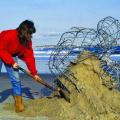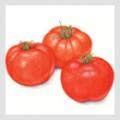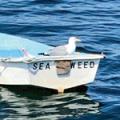Maine Course
A bycatch of lobster fishing turns into a tasty meal
By Nancy Harmon Jenkins
By Nancy Harmon Jenkins
I had a text message from my friend the food writer this spring: "Could you use some whelks?"
"Yes," said I, always ready for a fresh challenge in the kitchen, "yes of course, but where are you?"
"Fishing for lobster," came the reply. It stood to reason. That is the time of year when magazine and newspaper food editors start planning their summer issues and, surprising as it might seem in the chillier reaches of Penobscot Bay, that means an upcoming lobster feature for sure. So, even though many fishermen are reluctant to put their traps in the water before the end of June, a resourceful food writer, given an assignment, can usually find someone, even in late April, willing to haul a few traps for the camera.
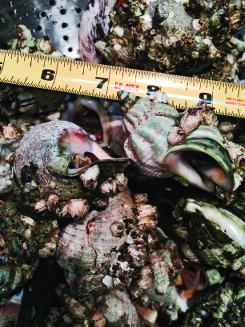 Whelks before cleaning.
Photo by Nancy Harmon Jenkins
And so it came to pass: that evening my food-writing friend arrived for dinner with a treasure-trove of muddy, gnarly, intimidating whelks, 50 of them, the bycatch, so to speak, of her day fishing for lobster.
Whelks before cleaning.
Photo by Nancy Harmon Jenkins
And so it came to pass: that evening my food-writing friend arrived for dinner with a treasure-trove of muddy, gnarly, intimidating whelks, 50 of them, the bycatch, so to speak, of her day fishing for lobster.
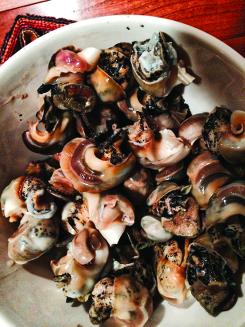 The whelks, cleaned and removed from their shells.
Photo by Nancy Harmon Jenkins
Whelks (Busycotypus carica, to be technical) crawl into lobster traps in their constant pursuit of good things to eat. Do they fancy lobster? I rather doubt it. Lobstermen apparently don't consider whelks a menace since their way of dealing with the critters is simply to heave them overboard. In any case, lobsters may be too speedy for slow-moving whelks. Maybe the whelks are attracted by the stinky lobster bait, but the pièces de résistance for these gastropods are clams and other bivalves, and the whelk way of attacking them is both ingenious and cruel-the whelk grasps the clam and holds it in place, rocking it back and forth while it slowly bores a hole through the hard shell. Once it reaches the soft tissue inside the whelk inserts its proboscis and ruthlessly consumes the clam. For commercial clam, oyster, or mussel cultivation, whelks are serious pests.
Now it was time for me to attack the whelks. I studied the literature, which is skimpy at best. None of the authoritative old Maine cookbooks on which I usually rely make mention of whelks at all, not even the very great Marjorie Mosser (Good Maine Cooking). But my daughter the chef has dealt with them in New York City where they are apparently considered a delicacy. Her advice was succinct: Poach them in aromatic water, then serve with snail butter. Chef Sam Hayward of Portland's Fore Street concurred, while admitting that even he has a hard time getting his kitchen staff to accept them.
So here's what I did: I scrubbed them to get rid of loose mud and sand, though they were so covered with barnacles that wasn't easy. Then I brought a large pot of water to a boil, flavoring it with a big spoonful of salt, a bunch of bay leaves, and a handful of grated lemon peel. I dropped in the whelks, held my breath, and waited for them to clamber up to the top of the pot. Miraculously, even though they had been moving around in their eerie, slow-motion way on my countertop, they were instantly overcome by the boiling water. How long to cook them? I went for 10 minutes, which turned out to be pretty good timing. They were done through, but not toughened by contact with heat. As soon as I could, I hauled them out of the water-I strained the cooking liquid and kept it, thinking of how tasty pasta might be cooked in whelk broth.
Getting them out of the shells was, surprisingly, a breeze, especially after Chef Sam counseled me to "twist the whelk in the direction of the spiral." This sounds tricky until you actually start to do it. With a lobster pick I stuck each whelk and did exactly that. The intestinal sac, a brownish pouch at the end, came off easily and then it was just a question of cutting away the operculum.
The what? The operculum is a fingernail-like stiff cartilage, the lid that protects the whelk when it's inside its shell. If you've ever picked snails off the rocks at low tide, you know exactly what I mean. It is not something you would want in your escargot.
The whelks and snail butter were fine (recipe on page 83). But I wanted another, more Italian dish, something closer to the scungilli alla marinara that I remembered from Italian-American restaurants in Boston's North End. Some say scungilli are conchs, others say they are whelks; in any case, it's clear the three gastropods are closely related. So why not try it?
This again will do for 40 to 50 whelks, enough for six servings. I used a short, stubby pasta called nodi marini (sailors' knots) which seemed appropriate but it's not a shape that's easy to find. You could also use small shells, fusilli, farfalle, or orecchiette-any twisted kind of shape that will trap bits of the delicious sauce.
Following an interesting recipe for escargots in a French cookbook, I marinated the chopped whelks in a combination of 1½ tablespoons of finely minced flat-leaf parsley and a clove of garlic, the latter crushed with the flat blade of a knife and chopped fine. I tossed this with the chopped whelks, then set them aside in the refrigerator, covered with plastic wrap, while I made the sauce (see recipe page 84).
The result was stupendous: the pasta was cooked just until appropriately al dente in a mixture of water and whelk broth, which gave it a nice marine flavor, and the sauce, with its curious and not very Italian assemblage of seasonings-fennel, cumin, chili pepper, and bay leaves-was so delicious that I'm not going to wait for the next whelk treasure to arrive. I'm going to chop up a mess of steamed hen clams and finish them in my marinara. I might even chunk a pound or so of lobster meat and warm it up in the sauce. And then, when and if Maine shrimp season rolls around again next winter, I'll make sure I've got everything on hand for a delicious Italo-Maine dish of gamberetti alla marinara della Costa di Maine-Coast o' Maine shrimps in a spicy marinara sauce. Shoot, I could happily eat the sauce alone over a nice bowl of pasta and to heck with the whelks.
Nancy Harmon Jenkins is the author of many books, and contributor to The New York Times, Bon Appetit, and numerous other publications. She lives in Maine and Tuscany.
Video: Watch a slow-moving and eerie whelk on the kitchen counter, prior to its journey toward becoming a meal.
Video courtesy Nancy Harmon Jenkins
The whelks, cleaned and removed from their shells.
Photo by Nancy Harmon Jenkins
Whelks (Busycotypus carica, to be technical) crawl into lobster traps in their constant pursuit of good things to eat. Do they fancy lobster? I rather doubt it. Lobstermen apparently don't consider whelks a menace since their way of dealing with the critters is simply to heave them overboard. In any case, lobsters may be too speedy for slow-moving whelks. Maybe the whelks are attracted by the stinky lobster bait, but the pièces de résistance for these gastropods are clams and other bivalves, and the whelk way of attacking them is both ingenious and cruel-the whelk grasps the clam and holds it in place, rocking it back and forth while it slowly bores a hole through the hard shell. Once it reaches the soft tissue inside the whelk inserts its proboscis and ruthlessly consumes the clam. For commercial clam, oyster, or mussel cultivation, whelks are serious pests.
Now it was time for me to attack the whelks. I studied the literature, which is skimpy at best. None of the authoritative old Maine cookbooks on which I usually rely make mention of whelks at all, not even the very great Marjorie Mosser (Good Maine Cooking). But my daughter the chef has dealt with them in New York City where they are apparently considered a delicacy. Her advice was succinct: Poach them in aromatic water, then serve with snail butter. Chef Sam Hayward of Portland's Fore Street concurred, while admitting that even he has a hard time getting his kitchen staff to accept them.
So here's what I did: I scrubbed them to get rid of loose mud and sand, though they were so covered with barnacles that wasn't easy. Then I brought a large pot of water to a boil, flavoring it with a big spoonful of salt, a bunch of bay leaves, and a handful of grated lemon peel. I dropped in the whelks, held my breath, and waited for them to clamber up to the top of the pot. Miraculously, even though they had been moving around in their eerie, slow-motion way on my countertop, they were instantly overcome by the boiling water. How long to cook them? I went for 10 minutes, which turned out to be pretty good timing. They were done through, but not toughened by contact with heat. As soon as I could, I hauled them out of the water-I strained the cooking liquid and kept it, thinking of how tasty pasta might be cooked in whelk broth.
Getting them out of the shells was, surprisingly, a breeze, especially after Chef Sam counseled me to "twist the whelk in the direction of the spiral." This sounds tricky until you actually start to do it. With a lobster pick I stuck each whelk and did exactly that. The intestinal sac, a brownish pouch at the end, came off easily and then it was just a question of cutting away the operculum.
The what? The operculum is a fingernail-like stiff cartilage, the lid that protects the whelk when it's inside its shell. If you've ever picked snails off the rocks at low tide, you know exactly what I mean. It is not something you would want in your escargot.
The whelks and snail butter were fine (recipe on page 83). But I wanted another, more Italian dish, something closer to the scungilli alla marinara that I remembered from Italian-American restaurants in Boston's North End. Some say scungilli are conchs, others say they are whelks; in any case, it's clear the three gastropods are closely related. So why not try it?
This again will do for 40 to 50 whelks, enough for six servings. I used a short, stubby pasta called nodi marini (sailors' knots) which seemed appropriate but it's not a shape that's easy to find. You could also use small shells, fusilli, farfalle, or orecchiette-any twisted kind of shape that will trap bits of the delicious sauce.
Following an interesting recipe for escargots in a French cookbook, I marinated the chopped whelks in a combination of 1½ tablespoons of finely minced flat-leaf parsley and a clove of garlic, the latter crushed with the flat blade of a knife and chopped fine. I tossed this with the chopped whelks, then set them aside in the refrigerator, covered with plastic wrap, while I made the sauce (see recipe page 84).
The result was stupendous: the pasta was cooked just until appropriately al dente in a mixture of water and whelk broth, which gave it a nice marine flavor, and the sauce, with its curious and not very Italian assemblage of seasonings-fennel, cumin, chili pepper, and bay leaves-was so delicious that I'm not going to wait for the next whelk treasure to arrive. I'm going to chop up a mess of steamed hen clams and finish them in my marinara. I might even chunk a pound or so of lobster meat and warm it up in the sauce. And then, when and if Maine shrimp season rolls around again next winter, I'll make sure I've got everything on hand for a delicious Italo-Maine dish of gamberetti alla marinara della Costa di Maine-Coast o' Maine shrimps in a spicy marinara sauce. Shoot, I could happily eat the sauce alone over a nice bowl of pasta and to heck with the whelks.
Nancy Harmon Jenkins is the author of many books, and contributor to The New York Times, Bon Appetit, and numerous other publications. She lives in Maine and Tuscany.
Video: Watch a slow-moving and eerie whelk on the kitchen counter, prior to its journey toward becoming a meal.
Video courtesy Nancy Harmon Jenkins
 Whelks before cleaning.
Photo by Nancy Harmon Jenkins
Whelks before cleaning.
Photo by Nancy Harmon Jenkins
 The whelks, cleaned and removed from their shells.
Photo by Nancy Harmon Jenkins
The whelks, cleaned and removed from their shells.
Photo by Nancy Harmon Jenkins
Whelks and Snail Butter
40 to 50 cooked, cleaned whelks (see directions in the story)
2 sticks unsalted butter, preferably at room temperature
3 Tbsp. finely chopped garlic
½ tsp. Maine sea salt
½ cup finely chopped flat-leaf parsley
¼ cup finely chopped shallots
½ cup dry white wine
6 thick slices of crusty, whole-grain bread
Cut each whelk into three or four pieces and set aside.
You can make this butter by hand but it is easier in a food processor. Chop the butter roughly into pieces and put in the bowl of the processor, then pulse, on and off, until the butter is creamy.
Put the garlic and salt in a small bowl and using the back of a spoon, crush it to a paste. (Or if you have a mortar and pestle, they are perfect for this.)
Add the parsley and shallots to the butter and process, again in pulsing spurts, until it is thoroughly mixed and the butter is liberally dotted with green. Add the wine and process again. You want this to be quite creamy and not at all dry-if it's too dry, add a bit more wine. When it's a good consistency, add the garlic-salt paste and process very briefly, just enough to mix it all together. (Over-processing the garlic will make it bitter.)
When ready to serve, toast the bread slices (best over an open fire, but you may also use your kitchen toaster). Put a slice on each of six plates and smear a little of the snail butter-a tablespoon or more-on each slice. Put the rest of the butter in a sauté pan or skillet and add the chopped whelks. Melt the butter over low heat and hold the whelks in it just long enough to warm them thoroughly without actually frying them. Spoon the whelks and plenty of melted snail butter over each piece of toast and serve immediately.
Whelks/Scungilli in a Spicy Marinara Sauce
40 to 50 cooked, cleaned whelks (see directions in the story)
1½ Tbsp. chopped flat-leaf (Italian) parsley
1 garlic clove, peeled and finely chopped
For the sauce:
3 Tbsp. extra-virgin olive oil
¼ cup pancetta or bacon, diced small
½ red sweet pepper, trimmed and diced
2 cloves garlic, crushed with the flat blade of a knife
½ tsp. sea salt
½ medium onion, chopped fine
1 plump shallot, chopped fine
1 14-ounce can whole San Marzano tomatoes
1 cup dry white wine
1 cup strained liquid left from simmering the whelks
1 tsp. fennel seed, crushed in a mortar
1 big pinch of ground cumin
1 big pinch of chili pepper or to taste (piment d'Espelette is my choice)
2 bay leaves
1 cinnamon stick, about 2" long
Sea salt and pepper to taste
Cut each of the whelks in three or four pieces and mix them in a bowl with the parsley and garlic. Cover and set aside for at least 30 minutes or longer (refrigerated if longer).
For the sauce, combine the olive oil and pancetta in a heavy saucepan or skillet and set over medium heat. Add the diced sweet pepper and cook gently just until the fat in the pancetta starts to run, the cubes are beginning to brown on their edges, and the pepper dice are softening.
While this is going on, combine the garlic and sea salt in a small bowl and crush to a paste, using the back of a spoon. Chop the onion and shallot together to make a fine mince. Add the garlic paste, mixing well, and stir the combination into the saucepan with the pancetta. Add the tomatoes, breaking them up into smaller pieces with your hands. Then add all the juice from the tomatoes. Stir in the wine and the strained whelk poaching liquid. Add the aromatics-fennel seed, cumin, piment d'Espelette, bay leaves, cinnamon-and salt and pepper to taste.
Let the sauce come to a simmer, then turn it down so that it barely simmers and cook for 1½ to 2 hours or until it has been reduced by half. If the sauce starts to burn on the bottom, stir in a little more liquid-wine, poaching liquid, or plain water. The sauce will thicken and give off an enticing aroma. (You can do this well ahead of time and reheat the sauce when you're ready to serve the pasta.)
Bring a large pot (about 4 quarts) of water to a rolling boil and add a large spoonful of salt. While the pasta water is heating, reheat, if necessary, the marinara sauce and stir in the whelks. Keep the heat under the sauce low enough so that it is just barely simmering. The point is to reheat the whelks but not to toughen them with further cooking.
When the salty water has returned to a boil, tip in the pasta and cook according to package directions. Have a warm serving bowl ready. Drain the pasta when it's al dente and transfer immediately to the warm bowl. Stir in about half of the sauce and top the pasta with the remaining sauce. Serve immediately. Makes 4 to 6 servings. Grated cheese? I wouldn't, but of course you may, if you wish.
Related Articles
Share this article:
2023 Maine Boat & Home Show

Join Us for the Maine Boat & Home Show!
Art, Artisans, Food, Fun & Boats, Boats, Boats
August 11 - 13, 2023 | On the waterfront, Rockland, Maine
Click here to pre-order your tickets.
Show is produced by Maine Boats, Homes & Harbors magazine.









